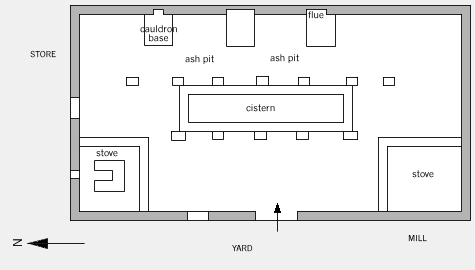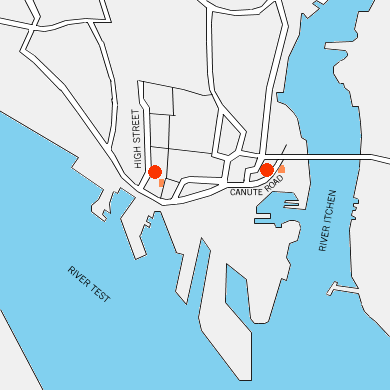There is only evidence of one early sugar house in Southampton, that of John Brissault.
He built the refinery in about 1743, on the derelict site of the Friary to the east of the High St, with easy access to
the Town Quay and a ready supply of fresh water. Excavation of the site in the 1970s, led by the late Jonathan Drake of Southampton Museum of Archaeology, revealed
a rectangular sugar house, approx 26m x 14m(1) ....

.... and 20C photographs(2) show the building to have been of 7
storeys above ground. Evidence of boiling pans with ash pits along a longer wall, two stoves,
and a central cistern were found, and archived plans and documents show
associated cooperage, raw sugar store, sugar mill, and dwelling house. Fragments of moulds
and drip pots were found in the main refinery building and sealed into the surface of the yard,
too few though to indicate a normal breakage rate, suggesting that sherds were being disposed
of elsewhere or perhaps sold for road making.
John Brissault ran the sugar house for some 30 years until he was declared bankrupt
in 1774(3), and by 1786 the building was being used as a granary
(4). Evidence of use of the site and buildings(5)
shows that the Sugar House and Sugar House Lane retained their names until after WWII. The sugar
house remained intact until the Blitz of 1940, and was finally demolished about 1942. The
detailed excavation by Southampton Museum preceeded the site being built upon in 2001/2,
providing highly prestigious and expensive flats, town houses and maisonettes. Something
of what is left of the boundary walls have been preserved alongside Gloucester Place car
park.
A John (Jean) Brissault is found earlier running a refinery in Fieldgate St,
Whitechapel, London, in 1736. Married to Ester Gille, their son Jean was baptised in 1732
in the French Huguenot Church in Spitalfields. From 1760-4, four children were baptised to
John (Jean) Brissault and his wife Marie Anne Herbert in Spitalfields and Whitechapel,
and a further two 1766 and 1773 in Southampton.(6) This John Brissault wrote a
simple will(7) in 1765,
leaving his estate to his wife Mary Ann, which was proved by her oath in 1808 in London.
The Turquand website gives interesting first-hand information
about the Brissault family at the time. Leonard Turquand, a Frenchman, was an apprentice to Mr
Brissault at his Fieldgate St sugar house in 1736, and wrote ... "I was, as I before
mentioned taken in at Mr. Brissault's Sugar
house, where I laboured as a common workman, and fortunately for me, his cousin was a Frenchman
and head man. Styled the Boiler, with whom I could converse and by the grace of God I learned
to speak and understand English very well, for my mind was easier; although I worked very
hard , I slept well and soon recovered my health and spirits and continued labouring with
them during the space of one year and a half and at the end of this period my Grandfather
took a sugar house, situated in Pearl Street, Spitalfields, and associated me with him, and
what is very singular this said sugar house belonged to a Mrs. Brissault, who was mother to
the Brissault with whom I was placed to learn the business, and my Grandfather and I continued
in partnership together until the 26th. of January 1740 (the day on which I married) when he
retired and I carried on the business alone. In the year 1742, Mr. Brissault (the same that
I had learned the business of) made me the proposition of associating me with him, which I
accepted, and he and his wife went and resided at Southampton, and we went to live in the
house they quitted. We continued in partnership during the space of fifteen years, he coming
to town occasionally and that but very seldom. I was very uncomfortable some years, or during
the time his cousin remained my Boiler: but at last I took courage to dismiss him and after
that we went on more comfortably, but Mr. Brissault never cordially forgave me for so doing
until several years after we had broken up our partnership."
So, perhaps two generations of John Brissaults were involved with the Southampton refinery.
A John Brissault also owned a 90 acre plantation in St Andrew Parish, Jamaica, in
1754. No sugar was being produced, the good but mountainous land mainly supplying provisions,
with a small amount of coffee and ginger. There were 25 slaves and 10 cattle.(8)
The following advertisement helps a lot ...
1775 - TO be SOLD by AUCTION, by Order of the Assignees, at the Star Inn, in Southampton, on Wednesday the 17th Day of May next, at Three o'Clock in the Afternoon.
The several FREEHOLD and LEASEHOLD ESTATES, late belonging to JOHN BRISSAULT, Sugar Baker, a Bankrupt, situate within the TOWN of SOUTHAMPTON, in the following separate Lots:
Lot 1. A large, airy, substantial, well-built, and extremely convenient Sugar-House, consisting of seven Stories, with two arched Stoves, five Pans, and all other well-contrived Apparatus for carrying on an extensive Business; together with a good Dwelling-House adjoining to the said Sugar-House, and also a Mill-House, and spacious Lodging Rooms for Workman, and all necessary Cisterns, Store-Houses, Cooperage, Stabling, and Coal-House, and a large well-situated Piece of Land contiguous to the said Sugar-House, abutting upon the said High Street of the Town of Southampton, which Piece of Land measures 52 Feet in Front, and 106 Feet in Depth, and whereon may be erected two good Dwelling-Houses.
Lot 2. A Dwelling-House, with a good Shop in Front, and other Appurtenances, now in the Occupation of Mrs. Widdell, and a Piece of Land adjoining thereto, fronting the said High Street, containing in Breadth 15 Feet, or thereabouts, and in Depth 40 Feet, near unto the Land of the said Sugar-House.
Lot 3. A large and commodious Dwelling House, with all suitable Conveniences, and a good Garden, encompassed with a Wall communicating with the said Sugar-Houses Yard, late in the Occupation of the said John Brissault.
N.B. All the above Premises are Freehold.
Lot 4. A long Range of Storehouses, with Lofts over the same, and a Wharf adjoining thereto, very convenient for landing Goods thereon, and situate near the Quay, held under the Corporation of Southampton for a Term of 40 Years, renewable every 14 Years on an easy Fine and Quit-Rent.
At the same Time will be sold, either by Auction or private Contract, about 15,000 Pots and Moulds, together with all other Implements and Utensils lately used in the said Sugar-House for the making and refining of Sugars.
For further Particulars enquire of Mr. John Bridger; or Mr. William Brice, Assignees of the said Bankrupt's Estate, or of Mr. Reade, or Mr. Daman, Attorneys, in Southampton.
(Southampton St James Chronicle 1775.) (My thanks to Andy Russel of Southampton Archaeology.)
Other documents in Southampton City Record Office (also from Andy Russel of Southampton Archaeology) tell us that Brissault's property was granted in trust to Thomas Abraham. He willed it to John Bridger, linen draper, and his son-in-law William Brice, wine cooper. In 1784 the Bankruptcy Commissioner appointed Thomas Guillaume (a Southampton Alderman and distiller) and Richard Vernon Moody (Mayor 1782) to take care of the estate. By 1786 the building was being used as a granary (SCRO SC4/4/420).
77 High Street is probably the 'Lot 2' above, as it was once owned by 'John Brissault, sugar refiner', and was probably his dwelling house. After his bankruptcy it passed to Robert Cooper by the Bankruptcy Commissioners 1785.
In 1833 Benjamin Lester Lester and James Kemp of Poole leased the Sugar House property to William Colson Westlake, merchant. WCW by his will of 1837 devised it to William Foster and Edward and Samuel Thompson. In 1856 Edward and Samuel Thompson convey to John Elliot and CW Fuller the 'Sugar House, since converted to a granary with the cisterns for rainwater thereunder'.
A conveyance of 1856 says the 'dwelling house with vault thereunder' which adjoined the northwest corner of the Sugar House was formerly occupied by 'Elmes Balguy, sugar refiner'. This was probably an 18th century reference copied and re-copied into subsequent documents, as we know the Sugar House was a granary by the late 18th century. It's likely that Balguy was the 'boiler' and provided with a house on site, which, if the London pattern was followed (and Brissault was a London refiner), also doubled as the Men's Rooms, as listed in 'Lot 1' above.
**
A later refinery was built for Garton, Hill & Co on Canute Road about 1847 that
concentrated on the production of sugar for the brewing industry. It closed in 1882 when
William Garton decided to move production to Battersea in London.




